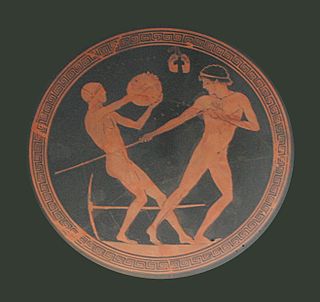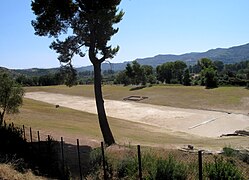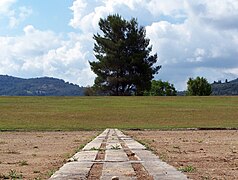
The 1896 Summer Olympics, officially known as the Games of the I Olympiad and commonly known as Athens 1896, was the first international Olympic Games held in modern history. Organised by the International Olympic Committee (IOC), which had been created by French aristocrat Pierre de Coubertin, it was held in Athens, Greece, from 6 to 15 April 1896.

At the 1896 Summer Olympics, the first modern Olympiad, twelve athletics events were contested. A total of 25 medals were awarded. The medals were later denoted as 37 modern medals. All of the events except the marathon were held in the Panathinaiko Stadium, which was also the finish for the marathon. Events were held on 6 April, 7 April, 9 April, and 10 April 1896. Altogether, 63 athletes, all men, from nine nations competed. This made athletics the most international of the nine sports at the 1896 Games.
The Olympic flame is a symbol used in the Olympic movement. It is also a symbol of continuity between ancient and modern games. Several months before the Olympic Games, the Olympic flame is lit at Olympia, Greece. This ceremony starts the Olympic torch relay, which formally ends with the lighting of the Olympic cauldron during the opening ceremony of the Olympic Games. The flame then continues to burn in the cauldron for the duration of the Games, until it is extinguished during the Olympic closing ceremony.

The 2004 Summer Olympics, officially the Games of the XXVIII Olympiad and also known as Athens 2004, were an international multi-sport event held from 13 to 29 August 2004 in Athens, Greece. The Games saw 10,625 athletes compete, some 600 more than expected, accompanied by 5,501 team officials from 201 countries, with 301 medal events in 28 different sports. The 2004 Games marked the first time since the 1996 Summer Olympics that all countries with a National Olympic Committee were in attendance, and also marked the first time Athens hosted the Games since their first modern incarnation in 1896 as well as the return of the Olympic games to its birthplace. Athens became one of only four cities at the time to have hosted the Summer Olympic Games on two occasions. A new medal obverse was introduced at these Games, replacing the design by Giuseppe Cassioli that had been used since 1928. The new design features the Panathenaic Stadium in Athens rectifying the long-running mistake of using a depiction of the Roman Colosseum rather than a Greek venue. The 2004 Games was the first of two consecutive Olympic games to be held in Southern Europe since the 1992 Summer Olympics in Barcelona, Spain, and was followed by the 2006 Winter Olympics in Turin, Italy.

Track and field is a sport that includes athletic contests based on running, jumping, and throwing skills. The name is derived from where the sport takes place, a running track and a grass field for the throwing and some of the jumping events. Track and field is categorized under the umbrella sport of athletics, which also includes road running, cross country running and racewalking.

A pentathlon is a contest featuring five events. The name is derived from Greek: combining the words pente (five) and -athlon (competition). The first pentathlon was documented in Ancient Greece and was part of the Ancient Olympic Games. Five events were contested over one day for the Ancient Olympic pentathlon, starting with the long jump, javelin throwing, and discus throwing, followed by the stadion and wrestling. Pentathletes were considered to be among the most skilled athletes, and their training was often part of military service—each of the five events in the pentathlon was thought to be useful in war or battle.

Stadion or stade was an ancient running event, part of the Ancient Olympic Games and the other Panhellenic Games. It was one of the five major Pentathlon events. It was the premier event of the gymnikos agon.

Olympia, officially Archaia Olympia, is a small town in Elis on the Peloponnese peninsula in Greece, famous for the nearby archaeological site of the same name. This site was a major Panhellenic religious sanctuary of ancient Greece, where the ancient Olympic Games were held every four years throughout Classical antiquity, from the 8th century BC to the 4th century AD. They were restored on a global basis in 1894 in honor of the ideal of peaceful international contention for excellence.

Adam McCright Nelson is an American shot putter and Olympic gold medalist. Nelson competed in three consecutive Olympic Games in 2000, 2004 and 2008. In addition to his gold medal at the 2004 Olympics, Nelson won a silver medal at the 2000 Olympics.

The men's discus throw competition at the 2004 Summer Olympics in Athens was held at the Olympic Stadium on 21–23 August. It was originally planned to hold the discus throw at the Ancient Olympia Stadium, but it was discovered that the field was not large enough to accommodate the range of modern discus throwers, and would have posed a danger to spectators. As such, it was decided to move the discus throw and to hold the shot put at the ancient stadium, despite the fact that the shot put was not contested at the Ancient Olympic Games. Thirty-nine athletes from 26 nations competed.

The palaestra at Olympia is the ground or grounds in ancient Olympia where πάλη, Doric πάλα, "wrestling," was taught and performed for training purposes; i.e., "wrestling-school." Two other martial arts were taught there: Greek πυγμή (pygme), Latin pugnus, "fist, boxing," and Greek παγκράτιον, Latin pancration or pancratium, "any method," which was free-style, or hand-to-hand, including grappling, kicking, punching, or any unarmed method whatever, no holds barred. The latter was sometimes deadly, or disfiguring, which indicates that the arts were ephebic, or "soldier" training for prospective citizens of the city-state sponsoring the school, such as Elis, but here combined with prospective candidacy for contention in the games. Be that as it may, none of the games were conducted without rules, umpires, and judges, who did not hesitate to stop contests, fine contenders with in some cases amounts prohibiting future participation, or bar flagrant violators.

The men's shot put at the 2004 Summer Olympics in Athens was held on 18 August 2004 at the Ancient Olympia Stadium. It was originally planned to hold the discus throw at this venue, but it was discovered that the field was not large enough to accommodate the range of modern discus throwers, and would have posed a danger to spectators. As such, it was decided instead to hold the shot put at the site, despite the fact that the shot put was not contested at the Ancient Olympic Games. All distances are given in metres. Thirty-nine athletes from 26 nations competed.
The women's shot put at the 2004 Summer Olympics in Athens was held on 18 August 2004 at the Ancient Olympia Stadium. It was originally planned to hold the discus throw at this venue, but it was discovered that the field was not large enough to accommodate the range of modern discus throwers, and would have posed a danger to spectators. As such, it was decided instead to hold the shot put at the site, despite the fact that the shot put was not contested at the Ancient Olympic Games. There were 38 competitors from 28 nations. After a series of doping-related disqualifications, the event was won by Koji Murofushi of Japan, the nation's first medal in the event. All distances are given in metres.
Athens 2010 Youth Olympics Bid is the official bid of Athens in order to host the first Youth Olympics. The Athens bid is one of the strong favourites as the Ancient Olympics started here, the Modern Olympics did as well. Athens was the host of the 1896 Summer Olympics the 2004 Summer Olympics and seven IOC Sessions. As stated on their website, Athens is eager to host the Games not only to utilize their state of the art venues, but to establish the Youth Olympics in the "birthplace" of the Modern and Ancient Games.

Diaulos was a double-stadion race, c. 400 metres , introduced in the 14th Olympiad of the ancient Olympic Games.
The dolichos or dolichus in the ancient Olympic Games was a long race introduced in 720 BC. Separate accounts of the race present conflicting evidence as to the actual length of the dolichos. However, the average stated length of the race was approximately 12.5 laps, or about three miles. The event was run similarly to modern marathons, but the race course would wind its way through the Olympic grounds. The course would often flank important shrines and statues in the sanctuary, passing by the Nike statue by the temple of Zeus before returning to the stadium.

The ancient Olympic Games were a series of athletic competitions among representatives of city-states and were one of the Panhellenic Games of Ancient Greece. They were held at the Panhellenic religious sanctuary of Olympia, in honor of Zeus, and the Greeks gave them a mythological origin. The originating Olympic Games are traditionally dated to 776 BC. The games were held every four years, or Olympiad, which became a unit of time in historical chronologies. They continued to be celebrated when Greece came under Roman rule in the 2nd century BC. Their last recorded celebration was in AD 393, under the emperor Theodosius I, but archeological evidence indicates that some games were still held after this date. The games likely came to an end under Theodosius II, possibly in connection with a fire that burned down the temple of the Olympian Zeus during his reign.

The Zappas Olympics, simply called Olympics at the time, were a series of athletic events held in Athens, Greece, in 1859, 1870, and 1875 sponsored by Greek businessman Evangelis Zappas. These games were one of the first revivals of the ancient Olympic Games in the modern era. Their success provided further inspiration for William Penny Brookes in England, whose games had been running since 1850, and the International Olympic Committee series from 1896.

Athletics were an important part of the cultural life of Ancient Greeks. Depictions of boxing and bull-leaping can be found back to the Bronze Age. Buildings were created for the sole use of athletics including stadia, palaestrae, and gymnasiums. Starting in the Archaic period, Panhellenic Games, including the Olympic Games, begin taking place each year. These games gave people from all over Greece the chance to gain fame for their athletic prowess. Athletics in Greece became one of the most commonly depicted scenes of everyday life in their art.




















